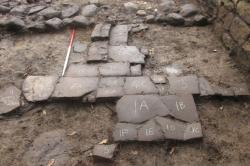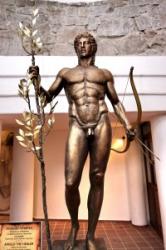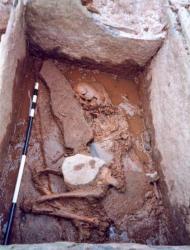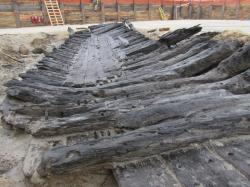INSTITUT SUPERIEUR D'ANTHROPOLOGIE
INSTITUTE OF ANTHROPOLOGY
ONLINE COURSES / COURS A DISTANCE
SPRING TERM : APRIL 2016
REGISTER NOW
ROYAUME UNI –  Warden - A community archaeological dig has located and excavated a Northumberland cottage at the centre of a murder mystery which gripped early 19th Century society. Joe the Quilter - elderly widower Joseph Hedley - was killed in his cottage on the outskirts of Warden, near Hexham, in January 1826. The murder was never solved, and was widely reported at the time with plans and drawings of the cottage being published. The documentation led archaeologists to what they believed was the site of the cottage, which had been demolished in 1872 and, with the help of local volunteers, the remains of the building have been uncovered. The dig was led by a team from Beamish Museum in County Durham, which has an example of Joe’s quilting work. A crucial piece of evidence found in the dig was a metal plate bearing the name of “Revd R Clarke, Walwick” which was attached to a piece of leather and was probably a saddle mount belonging to the clergyman. A historical account mentions how Joe would have been unlikely to survive a period of deep snow in 1823 had not “a Hexham clergyman, the Revd R Clarke, gone through drifts to his assistance after other efforts to reach him had failed.”
Warden - A community archaeological dig has located and excavated a Northumberland cottage at the centre of a murder mystery which gripped early 19th Century society. Joe the Quilter - elderly widower Joseph Hedley - was killed in his cottage on the outskirts of Warden, near Hexham, in January 1826. The murder was never solved, and was widely reported at the time with plans and drawings of the cottage being published. The documentation led archaeologists to what they believed was the site of the cottage, which had been demolished in 1872 and, with the help of local volunteers, the remains of the building have been uncovered. The dig was led by a team from Beamish Museum in County Durham, which has an example of Joe’s quilting work. A crucial piece of evidence found in the dig was a metal plate bearing the name of “Revd R Clarke, Walwick” which was attached to a piece of leather and was probably a saddle mount belonging to the clergyman. A historical account mentions how Joe would have been unlikely to survive a period of deep snow in 1823 had not “a Hexham clergyman, the Revd R Clarke, gone through drifts to his assistance after other efforts to reach him had failed.”
http://www.chroniclelive.co.uk/news/north-east-news/hexham-murder-mystery-cottage-uncovered-10694927
BULGARIE –  Apollonia Pontica - The Bulgarian Black Sea resort town of Sozopol, a successor of the Ancient Greek polis of Apollonia Pontica, is going to rebuild what once was a large ancient statue of god Apollothat was its symbol for several centuries during the Antiquity period. The initiative for rebuilding the 13-meter statue of Apollo, which stood on the Black Sea coast in ancient Apollonia Pontica, was first undertaken in 2011 by Sozopol Municipalitybut has not been materialized yet. In the 2nd-1st millennium BC, the area of today’s Sozopol in Southeast Bulgaria was settled by theAncient Thracian tribe Scyrmiades who were miners trading with the entire Hellenic world. TheAncient Greek colony was founded there in 620 BC by Greek colonists from Miletus on Anatolia’s Aegean coast. The colony was first called Anthea but was later renamed to Apollonia in favor of Ancient Greek god Apollo, a patron of the setters who founded the town. It became known as Apollonia Pontica (i.e. of the Black Sea). Since the Late Antiquity, the Black Sea town has also been called Sozopolis. In Apollonia Pontica, Apollo was worshipped under the name Iatros, i.e. the Healer. Thestatue of Apollo the Healer was erected by the Ancient Greek polis ca. 480 BC. It was designed by Calamis, the renowned sculptor fromAncient Athens, who was specially hired for the job. Towering at 13.2 meters, the Apollonia Pontica statue of Apollo was roughly twice smaller than the Colossus of Rhodes, which represented the Ancient Greek titan-god of the sun Helios. However, it was also 200 years older than the Colossus of Rhodes, and existed for much longer. The Colossus of Apollonia, as it is sometimes referred to, decorated the port of Sozopol for more than 400 years, until in 72 BC, Marcus Lucullus, one of the great generals of the Roman Republic, captured the city, seized the statue as a trophy, and had it transported to Rome, and installed on one of the historic hills of the Roman capital. In a media statement announcing the restart of the initiative for rebuilding the statue of Apollo the Healer in Bulgaria’s Sozopol, the Director of the National Museum of History in Sofia, Bozhidar Dimitrov (who happens to be a native of Sozopol), compares the Colossus of Apollo to the Colossus of Rhodes. The Colossus of Rhodes was about 30 meters tall (the recently announced Greek project provides for rebuilding it with a replica that will 135 meters tall), and is estimated to have existed for 54 years – from 280 BC until 226 BC, until it was brought down by a strong earthquake. After its collapse huge pieces of the statue lay along the Rhodes harbor for centuries. In the 7th century A.D., the Arabsconquered Rhodes and broke the remains of the Colossus up into smaller pieces and sold it as scrapmetal. The Colossus of Rhodes was made of bronze plates attached to iron framework, while the Colossusof Apollonia, today’s Sozopol, was fully cast of bronze, and remained at its original place for more than 400 years.
Apollonia Pontica - The Bulgarian Black Sea resort town of Sozopol, a successor of the Ancient Greek polis of Apollonia Pontica, is going to rebuild what once was a large ancient statue of god Apollothat was its symbol for several centuries during the Antiquity period. The initiative for rebuilding the 13-meter statue of Apollo, which stood on the Black Sea coast in ancient Apollonia Pontica, was first undertaken in 2011 by Sozopol Municipalitybut has not been materialized yet. In the 2nd-1st millennium BC, the area of today’s Sozopol in Southeast Bulgaria was settled by theAncient Thracian tribe Scyrmiades who were miners trading with the entire Hellenic world. TheAncient Greek colony was founded there in 620 BC by Greek colonists from Miletus on Anatolia’s Aegean coast. The colony was first called Anthea but was later renamed to Apollonia in favor of Ancient Greek god Apollo, a patron of the setters who founded the town. It became known as Apollonia Pontica (i.e. of the Black Sea). Since the Late Antiquity, the Black Sea town has also been called Sozopolis. In Apollonia Pontica, Apollo was worshipped under the name Iatros, i.e. the Healer. Thestatue of Apollo the Healer was erected by the Ancient Greek polis ca. 480 BC. It was designed by Calamis, the renowned sculptor fromAncient Athens, who was specially hired for the job. Towering at 13.2 meters, the Apollonia Pontica statue of Apollo was roughly twice smaller than the Colossus of Rhodes, which represented the Ancient Greek titan-god of the sun Helios. However, it was also 200 years older than the Colossus of Rhodes, and existed for much longer. The Colossus of Apollonia, as it is sometimes referred to, decorated the port of Sozopol for more than 400 years, until in 72 BC, Marcus Lucullus, one of the great generals of the Roman Republic, captured the city, seized the statue as a trophy, and had it transported to Rome, and installed on one of the historic hills of the Roman capital. In a media statement announcing the restart of the initiative for rebuilding the statue of Apollo the Healer in Bulgaria’s Sozopol, the Director of the National Museum of History in Sofia, Bozhidar Dimitrov (who happens to be a native of Sozopol), compares the Colossus of Apollo to the Colossus of Rhodes. The Colossus of Rhodes was about 30 meters tall (the recently announced Greek project provides for rebuilding it with a replica that will 135 meters tall), and is estimated to have existed for 54 years – from 280 BC until 226 BC, until it was brought down by a strong earthquake. After its collapse huge pieces of the statue lay along the Rhodes harbor for centuries. In the 7th century A.D., the Arabsconquered Rhodes and broke the remains of the Colossus up into smaller pieces and sold it as scrapmetal. The Colossus of Rhodes was made of bronze plates attached to iron framework, while the Colossusof Apollonia, today’s Sozopol, was fully cast of bronze, and remained at its original place for more than 400 years.
http://archaeologyinbulgaria.com/2016/01/05/bulgarias-sozopol-to-restore-ancient-statue-of-apollo-colossus-of-apollonia-pontica-not-unlike-greeces-plans-to-rebuild-colossus-of-rhodes/
ROYAUME UNI –  Thaxted - This weighty gold ring, dating from between the 10th and 12th centuries, was lost by a Viking in the Essex town of Thaxted. "The size and weight of the ring suggest that it was most likely worn by a man. It weighs over 32 grams and we know from X-ray fluorescence analysis at the British Museum that the metal is over 95% gold, the rest being silver and copper. That’s fairly common for gold of this date, to be a good standard. Vikings were very concerned with the purity of the metal. On silver coins you sometimes find little nicks made with a knife blade where they were testing that they’d got decent quality silver. The ring was made by twisting two strands of gold wire and then twisting these with two tapering gold rods to form a hoop. The thin ends of the rods and wires were joined at the back of the hoop by beating them together into a flat, diamond-shaped plate. The plate is decorated with tiny punched circles. This is a fairly widely-known style that goes throughout the Viking period. But the particular style we’ve got here, where they’ve hammered the rods into the plate at the back, is thought to be a feature of things made in Scandinavia. That’s the opinion of the British Museum report for the coroner because there are rings with a similar sort of plate on the back of the hoop found in Viking graves in Scandinavia. A metal detectorist reported the ring after finding it in 2013.
Thaxted - This weighty gold ring, dating from between the 10th and 12th centuries, was lost by a Viking in the Essex town of Thaxted. "The size and weight of the ring suggest that it was most likely worn by a man. It weighs over 32 grams and we know from X-ray fluorescence analysis at the British Museum that the metal is over 95% gold, the rest being silver and copper. That’s fairly common for gold of this date, to be a good standard. Vikings were very concerned with the purity of the metal. On silver coins you sometimes find little nicks made with a knife blade where they were testing that they’d got decent quality silver. The ring was made by twisting two strands of gold wire and then twisting these with two tapering gold rods to form a hoop. The thin ends of the rods and wires were joined at the back of the hoop by beating them together into a flat, diamond-shaped plate. The plate is decorated with tiny punched circles. This is a fairly widely-known style that goes throughout the Viking period. But the particular style we’ve got here, where they’ve hammered the rods into the plate at the back, is thought to be a feature of things made in Scandinavia. That’s the opinion of the British Museum report for the coroner because there are rings with a similar sort of plate on the back of the hoop found in Viking graves in Scandinavia. A metal detectorist reported the ring after finding it in 2013.
http://www.culture24.org.uk/history-and-heritage/archaeology/art544047-viking-gold-ring-saffron-walden-museum?
USA –  Alexandria - Archaeologists surveying the site of a new hotel in Alexandria, Virginia have uncovered the remains of a Revolutionary War-era ship buried in the mud of the Potomac River. After centuries of its muddy entombment, what’s left of the ship could give researchers new hints as to how 18th century colonists in North America built their boats, Patricia Sullivan reports for the Washington Post.Construction crews were first alerted to the ship’s existence in December 2015 when they uncovered it’s bow during the site’s excavation, Sullivan reports. Since then, archaeologists dug up almost a third of the original hull, stretching nearly 50 feet from keel, to framework, to stern. It’s unclear exactly what the ship was originally used for or who built it, but researchers suspect that it could have been a large cargo ship or a military vessel. According to Baicy, the ship’s wooden hull was well preserved thanks to the oxygen-starved mud it was buried in. Without air bubbles to help speed along the ship’s decomposition, the remains survived in the murky, muddy silt of the Potomac. This week, archaeologists will document the ship with 3D scans, photographs, and drawings on site before removing its remains for storage in tanks of water until it can be studied by a preservation laboratory. Meanwhile, archaeologists will continue to survey the site, where Baicy’s team has also uncovered three separate outhouses that back in the day doubled as colonial trash cans—a veritable treasure trove for archaeologists wanting to learn more about how the early American colonists lived.
Alexandria - Archaeologists surveying the site of a new hotel in Alexandria, Virginia have uncovered the remains of a Revolutionary War-era ship buried in the mud of the Potomac River. After centuries of its muddy entombment, what’s left of the ship could give researchers new hints as to how 18th century colonists in North America built their boats, Patricia Sullivan reports for the Washington Post.Construction crews were first alerted to the ship’s existence in December 2015 when they uncovered it’s bow during the site’s excavation, Sullivan reports. Since then, archaeologists dug up almost a third of the original hull, stretching nearly 50 feet from keel, to framework, to stern. It’s unclear exactly what the ship was originally used for or who built it, but researchers suspect that it could have been a large cargo ship or a military vessel. According to Baicy, the ship’s wooden hull was well preserved thanks to the oxygen-starved mud it was buried in. Without air bubbles to help speed along the ship’s decomposition, the remains survived in the murky, muddy silt of the Potomac. This week, archaeologists will document the ship with 3D scans, photographs, and drawings on site before removing its remains for storage in tanks of water until it can be studied by a preservation laboratory. Meanwhile, archaeologists will continue to survey the site, where Baicy’s team has also uncovered three separate outhouses that back in the day doubled as colonial trash cans—a veritable treasure trove for archaeologists wanting to learn more about how the early American colonists lived.
http://www.smithsonianmag.com/smart-news/revolution-era-ship-found-hotel-construction-site-180957713/?no-ist
INDE –  Nizamuddin - A year after work to restore the 17th century tomb of Abdul Rahim Khan-i-Khanan began in Nizamuddin, there is excitement among conservationists. They have found that intricate plaster patterns in the interior chambers have survived the centuries. Now perhaps when the facelift is completed in around two years' time, the resting place of one of Emperor Akbar's Navaratna will deservedly earn the esteem of tourists and Mughal experts. After all, it is one of the two mausoleums that inspired the majestic Taj Mahal, the other being the resplendent Humayun's Tomb, just 100 metres northward. The conservation project launched in November last year by the Aga Khan Trust for Culture with the support of Interglobe Foundation and in partnership with the Archaeological Survey of India has unearthed the architectural highlights of the interior chambers. Once the task of removing several layers of 20th century lime wash started, officials overseeing the conservation were delighted to see the incised plaster patterns, created over 400 years ago, mostly intact. They were obscured by layers of grime and soot, and had to be painstakingly cleaned with soft brushes and distilled water. Popularly known as Rahim, Khan-i-Khanan was one of Akbar's Navratnas and, besides being a powerful military commander and able administrator, was also a great scholar and poet. His dohas (couplets) are well regarded throughout India. Historians say he stayed in regular contact with Tulsidas, poet-saint and author of Ramcharitmanas, and translated the Ramayana into Persian. As with Humayun's Tomb built only a few years earlier, this tomb was initially built by Rahim for his wife at a spot chosen for its proximity to the dargah of Hazrat Nizamuddin Auliya. On its completion in 1598, it was the first ever Mughal tomb built for a woman. Rahim's body too was interred there in 1627.
Nizamuddin - A year after work to restore the 17th century tomb of Abdul Rahim Khan-i-Khanan began in Nizamuddin, there is excitement among conservationists. They have found that intricate plaster patterns in the interior chambers have survived the centuries. Now perhaps when the facelift is completed in around two years' time, the resting place of one of Emperor Akbar's Navaratna will deservedly earn the esteem of tourists and Mughal experts. After all, it is one of the two mausoleums that inspired the majestic Taj Mahal, the other being the resplendent Humayun's Tomb, just 100 metres northward. The conservation project launched in November last year by the Aga Khan Trust for Culture with the support of Interglobe Foundation and in partnership with the Archaeological Survey of India has unearthed the architectural highlights of the interior chambers. Once the task of removing several layers of 20th century lime wash started, officials overseeing the conservation were delighted to see the incised plaster patterns, created over 400 years ago, mostly intact. They were obscured by layers of grime and soot, and had to be painstakingly cleaned with soft brushes and distilled water. Popularly known as Rahim, Khan-i-Khanan was one of Akbar's Navratnas and, besides being a powerful military commander and able administrator, was also a great scholar and poet. His dohas (couplets) are well regarded throughout India. Historians say he stayed in regular contact with Tulsidas, poet-saint and author of Ramcharitmanas, and translated the Ramayana into Persian. As with Humayun's Tomb built only a few years earlier, this tomb was initially built by Rahim for his wife at a spot chosen for its proximity to the dargah of Hazrat Nizamuddin Auliya. On its completion in 1598, it was the first ever Mughal tomb built for a woman. Rahim's body too was interred there in 1627.
http://timesofindia.indiatimes.com/city/delhi/400-year-old-plaster-patterns-found-in-chamber-of-Nizamuddin-tomb/articleshow/50469448.cms